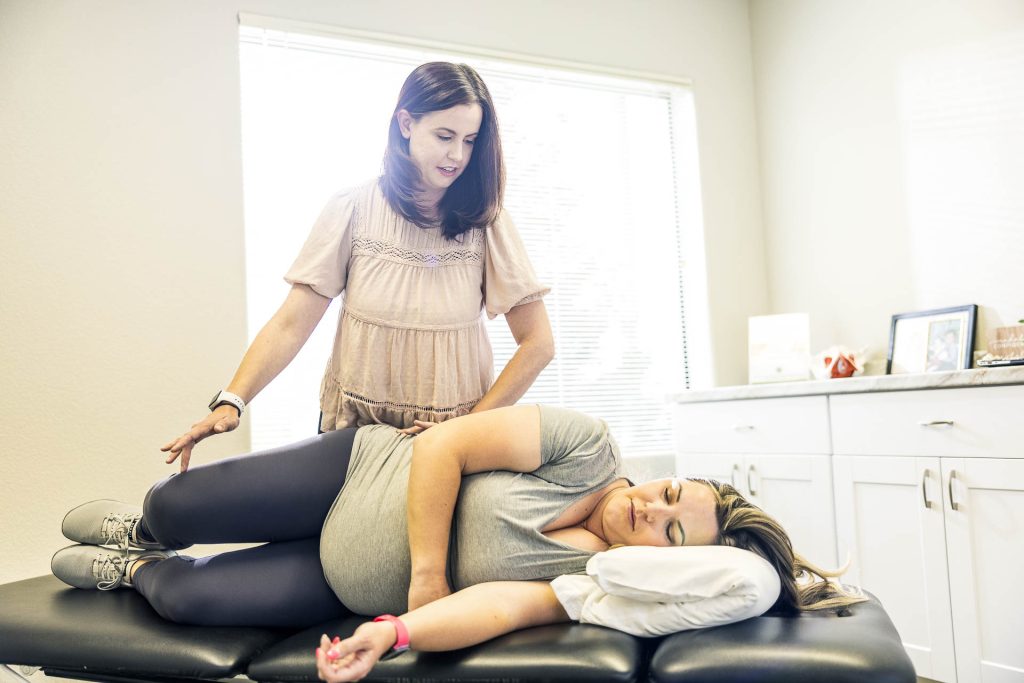Prenatal Chiropractic and Physical Therapy Help Relieve Sciatica Pain
Sciatica pain is one of the most common symptoms of pregnancy. It ranges in intensity from severe and debilitating to more mild aches and numbness. Sciatica pain can be present all throughout pregnancy, but tends to be more prevalent in the third trimester when the baby is bigger and more likely to push on those nerves in the lumbar spine.
What are the Symptoms of Sciatica?
Sciatica presents as numbness, tingling and/or sharp/shooting pains into the butt or down the leg, even sometimes to the foot. It is a result of pressure on the sciatic bundle or any of the nerves that exit the lumbar spine.
Why is it Common in Pregnancy?
A pregnant woman’s body is constantly changing and adapting to keep up with the growing baby. As baby grows, belly grows forward and mom’s skeletal posture must change to adapt to a new center of gravity for balance and support. With these postural changes, specific muscles associated with the pelvis must work more while others start to take a backseat. More specifically, the piriformis is worked harder and the culprit for most sciatic pain in pregnancy. The piriformis is an external rotator for the femur and it lies over the sciatic bundle. When it is overused to help stabilize the rapidly growing and changing pregnant woman, it will put pressure on the sciatic bundle causing numbness, tingling and/or sharp/shooting pains into the butt or leg.
Co-Management of Care for Pregnant Women
If you are experiencing sciatica in pregnancy, there is treatment and relief. At Northern Nevada Chiropractic, our prenatal chiropractor, Dr. Kimberly Nelson works with patients who are experiencing sciatica pain and will often partner with other specialists, like the prenatal physical therapist, Dr. Sarah Martinez, DPT at Battle Born Health in Reno, or Erin Hansen, prenatal massage therapist at Biggest Little Baby. She says if a patient is not holding adjustments or when proper function is not returning and symptoms are not being resolved, this is an ideal opportunity to partner with another specialist for care.
“Co-management is key to success for my pregnant patients,” Dr. Nelson says. “I often refer to massage therapists, acupuncturists, physical therapists, or occupational therapists depending on the needs of the patient.”
Through pregnancy, Dr. Nelson uses activator and Webster’s Technique to help align the pelvis and lumbar spine. She does a lot of soft tissue work in the glutes, hamstrings, low back and hip flexors to keep up with the demand of the changing pregnant body.
Dr. Nelson highly encourages massage therapy through pregnancy, especially if the patient is suffering with sciatic pain. Having a good 60-90 minutes to focus on muscle release helps to reduce the tension placed on the skeletal system and nervous system and allows patients to hold their adjustments longer while minimizing symptoms and discomfort.
She also highly encourages physical therapy for patients who need to strengthen weak muscles that might be creating a greater imbalance in the muscles of the pelvis. This imbalance makes it very difficult to hold your chiropractic adjustments long term.
Dr. Sarah Martinez, DPT of Battle Born Health works with moms-to-be on strengthening the core including hips and pelvic floor to help alleviate sciatic pain and better prepare the body for delivery.
“Consistency with your home exercise program and coming to your physical therapy appointments are key to success in regards to alleviating discomfort during pregnancy,” Dr. Martinez says.
What are things women can do on their own to relieve sciatica pain between treatments?
Pregnancy comes with a lot of doctor’s appointments, even if you are not suffering from sciatica or other complications. So you want to be able to do things at home that can help ease discomfort. Dr. Nelson says it is important to pay attention to your posture!
“Symmetry is key in avoiding pain. You want to bear your weight equally when sitting or standing and use lumbar support when seating,” she says. “Do not sit on wallets or cross your legs and use pillow support between the knees and ankles when side sleeping.”
She also encourages patients to stretch regularly, do Epsom salt baths, and use the lacrosse ball daily on tight muscles.
Dr. Martinez, DPT advises her patients to do regular, weekly exercise to build strength and ease pain. She says it is ideal to exercise four to five days a week for 20 to 30 minutes throughout your pregnancy.
“Exercising when you are pregnant improves blood pressure, overall strength and fitness, and reduces the chances of gestational diabetes,” Dr. Martinez, DPT says. “Additionally back pain is also reduced with exercise, and that strength and mobility you gain through regular movement can help with delivery. Also, regular exercise helps keep the digestive tract healthy and prevents or eases any constipation issues.”
Postpartum Chiropractic and Physical Therapy for Rehabilitation
Postpartum is a vulnerable time for women to experience pain and destabilization after giving birth. The increased weight, changes in posture, and loss of core strength during pregnancy exacerbate sciatica symptoms. Stabilizing after giving birth is very important because it helps to restore healthy posture, which will protect your spine and reduce any neck, shoulder, or back pain.
“This is an especially important time for co-management,” Dr. Nelson says. “Chiropractic adjustments keep the spine and pelvis aligned to minimize stress in the joint, but rehabilitation of core stabilizer muscles with a physical therapist will help to stabilize the injured area as it heals and prevents future occurrences.”
Physical therapists often treat pelvic floor issues and diastasis recti after childbirth. Pelvic floor issues range from painful intercourse to incontinence. After giving birth women can present with either a “tight” pelvic floor or “weak” pelvic floor.
Diastasis recti is when the midline of your stomach muscles separates significantly during pregnancy and has a hard time coming back together after delivery. This can create a protruded abdomen and causes instability because of the weakened abdominal muscles.
Both diastasis recti and pelvic floor issues are a whole-body problem. The most effective recovery exercises for both are proper breathing techniques. Both Dr. Nelson and Dr. Martinez, DPT work with new moms to retrain their breathing system to get the diaphragm back on board and engage with the pelvic floor. This also helps to fire the abdominal muscles to get them engaged. If the diaphragm does not fully function, then the abdominal muscles can’t either. It is all connected. And if the patient keeps up with at home exercises, breathing, and stretches, they will heal much faster.





